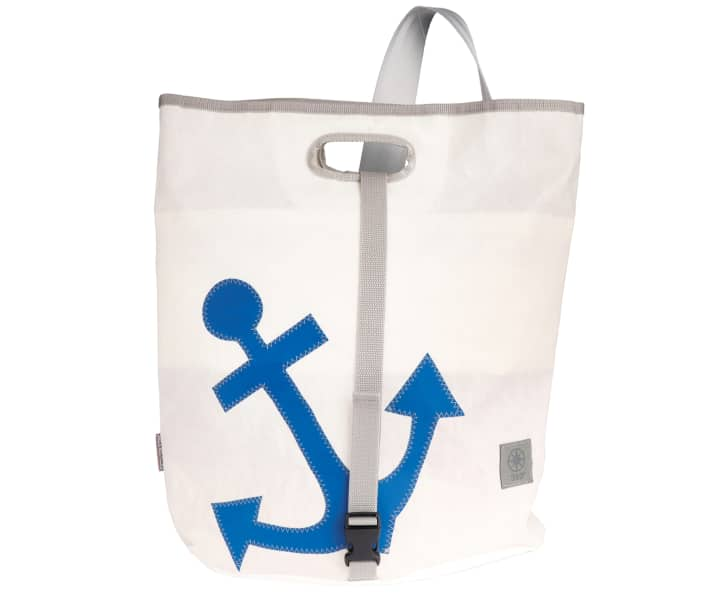Sail recycling: Not just stylish bags - what happens to old cloth

What actually happens to the old sail? Carrying it on board as a spare for emergencies is probably only an option for very few people. Depending on its condition, reselling it in a classified advert will only meet with limited demand. So attic or rubbish bin?
Sabine Moormann, a folk boat owner, passionate sailor and founder of the fashion brand 8 Beaufort, knows that neither is a good idea. Under the label, the Hamburg native and her company make shoes from discarded sails.
Approaches like that of 8 Beaufort are in vogue. There are dozens of similar initiatives across Europe to create something new from old sails. Tens of thousands of square metres of polyester or Dyneema fabric and more and more laminates are created every year for sailing alone, and only a small proportion of discarded clothing has been recycled to date.
Canvas bags are a win-win situation
Long before the topic of sustainability became omnipresent, Edzard Kramer had already started to give old sails a second life with the help of his sewing machine. Today, he produces and sells dozens of bag models, rucksacks and home accessories under his 360° brand - all made primarily from old sails.
"It's a win-win situation," says Kramer. "Sailors don't have to throw away their sails, but get a bit of money or a canvas bag when they hand them in." Trim threads, seams or sail numbers become eye-catchers. The same applies to the signs of use, which give the recycled bags and lamps their special charm.
However, some materials can also be functionally recycled, although not yet for new sails, but for fittings and other plastic parts. However, there is one way to make sails exclusively from recycled materials: from shredded PET bottles! We show the most exciting developments in the field of sail recycling - classic and modern.
360° bags and rucksacks: faithful companions

The 360° brand's range includes bags and rucksacks. You can also design your own bag online. From 130 euros
8 Beaufort: good on foot

Women's and men's shoes, accessories and bags are available from the Hamburg label 8 Beaufort. A pair of trainers from 150 euros
Elvstrøm Ekko series: from the bottle

With the Ekko series, Elvstrøm offers cruising laminates whose main components are made from 100 per cent recycled plastic. Both the load-bearing fibres, the foil and the taffeta fabric applied to the outside are made from PET bottles and are therefore produced sustainably. Instead of using up raw materials, the sails reduce the mountain of plastic waste that has been growing steadily for decades. Around 2,000 PET bottles find a new use for the sails of a 38-foot boat. Polyester loses almost ten per cent of its strength when it is recycled. However, this is compensated for by the higher fibre content of the Ekko sails.
Beachbreak: strong fashion

The Beachbreak collection ranges from toiletry bags and laptop bags to jackets made from kite sails. Shoulder bags from 19 euros
Onesails 4T-Forte membrane: reusable membrane

Aramid and carbon fibres are generally used in high-performance sails, and often blends of the two. Once combined to form a laminate, the materials can no longer be separated. The 4T Forte membrane from Onesails is different. It consists of high-strength polyethylene filaments, similar to Dyneema. The funny thing is that the sail consists exclusively of polyethylene and does not require any glue or film, so it can be recycled separately. Unfortunately, new sails cannot yet be made from the recycled material, but fittings and other plastic parts can.
Further topics in the sustainability special:
- 25 tips to help you sail more environmentally friendly
- These projects are available for marine conservation
- Sailing yacht vs. motorboat: which model is more sustainable?
- Boatbuilding ecolution: These shipyards are working on sustainable concepts
- Shipyard portrait Greenboats: Boats made of flax and components for Boris Herrmann
- Sustainable fashion: oilskins and other functional clothing - the best products
- Boat recycling: the never-ending story of GRP
- "Losing is not an option"- Boris Herrmann on sustainability in motorsport
- Sustainable management: Wooden boats in charter operations
- Equipment: Every sailor should reach for these green alternatives
- Drinking water on board: you can filter water correctly using these methods
- Baltic Sea: How does a harbour become sustainable?
- Research yachts: Climate protectors under sail
- Pallets, bottles, flip-flops: creative recycling ideas in boatbuilding
- Monsoon 31: Greenfit instead of refit, what does that mean for the 50-year-old Hallberg-Rassy?
- "Nomade des Mers": a catamaran as a low-tech laboratory
- Self-build yacht "Ya": Totally self-sufficient on a trip around the world
- Sustainable boat project: 55-foot catamaran made from recycled aluminium
- The Schwörer family and the "Pachamama": On a long voyage for climate protection
- Nike Steiger on her recycling project

